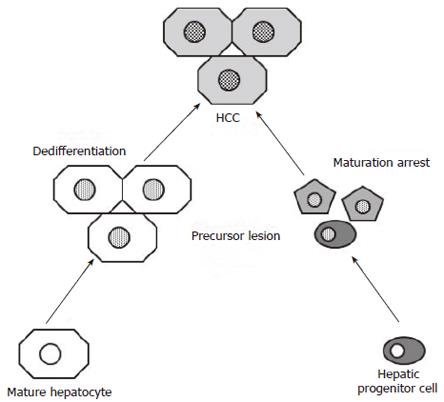Copyright
©2006 Baishideng Publishing Group Co.
World J Gastroenterol. Oct 21, 2006; 12(39): 6261-6265
Published online Oct 21, 2006. doi: 10.3748/wjg.v12.i39.6261
Published online Oct 21, 2006. doi: 10.3748/wjg.v12.i39.6261
Figure 1 Schematic representation of the “maturation arrest” hypothesis and the “dedifferentiation” hypothesis applied to hepatocellular carcinoma and its precursor lesions.
According to the “maturation arrest” hypothesis, genetic alterations (grid in nuclei) occurring in hepatic progenitor cells causes proliferation and incomplete differentiation of these cells, eventually leading to hepatocellular carcinomas that express hepatic progenitor cell markers (grayscale) as an evidence of their cellular origin. In this scenario, precursor lesions contain hepatic progenitor cells and intermediate cells (the small polygonal cells). The “dedifferentiation” hypothesis states that the expression of hepatic progenitor cell markers in hepatocellular carcinoma is merely a result of tumor progression and consequently the precursor lesions should only consist of mature hepatocytes.
- Citation: Libbrecht L. Hepatic progenitor cells in human liver tumor development. World J Gastroenterol 2006; 12(39): 6261-6265
- URL: https://www.wjgnet.com/1007-9327/full/v12/i39/6261.htm
- DOI: https://dx.doi.org/10.3748/wjg.v12.i39.6261









